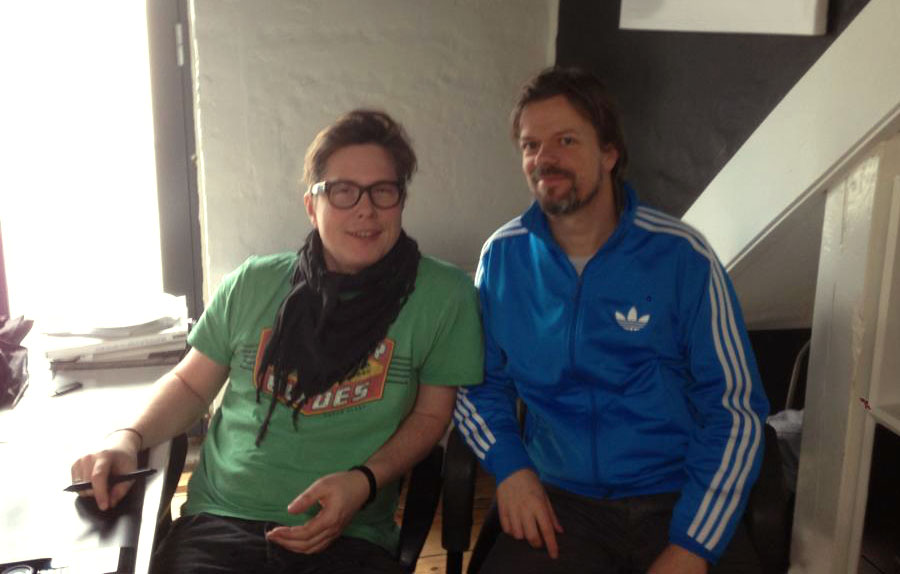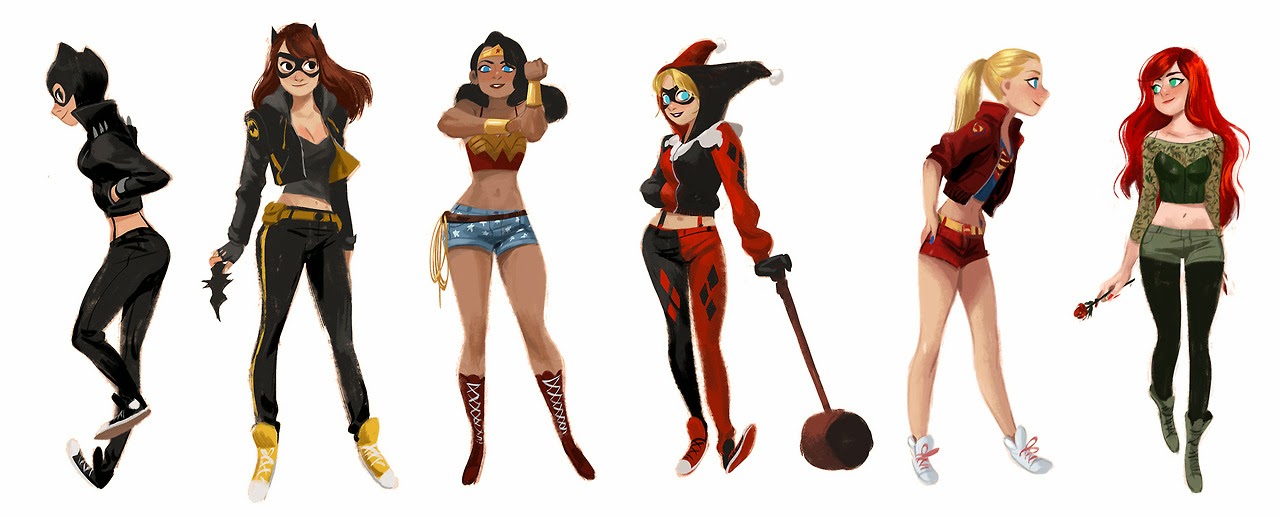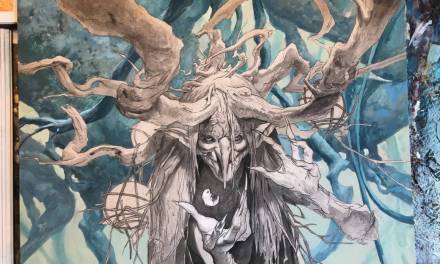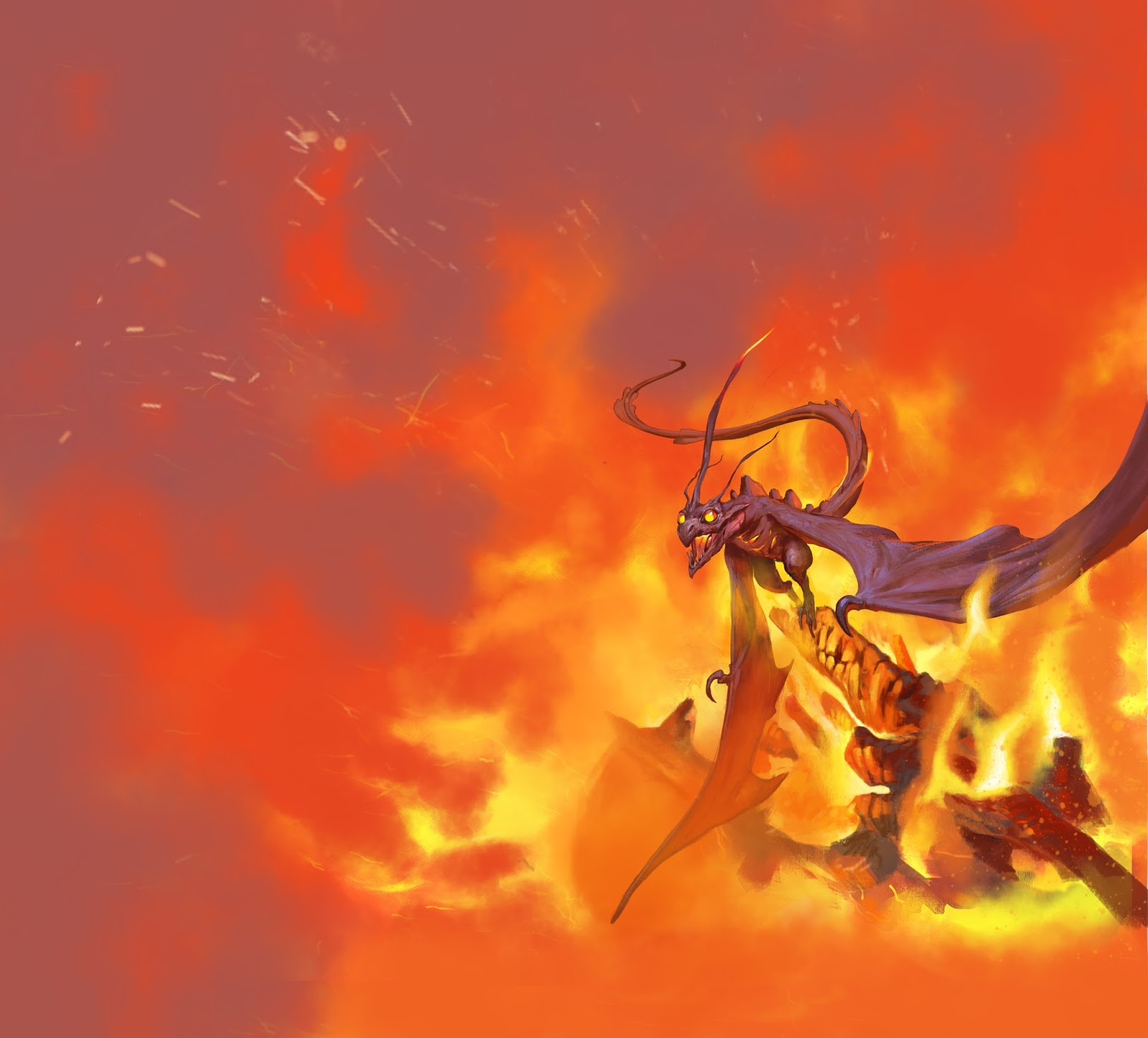 |
| Jesper and Peter at the game Studio |
I recently started doing a lot of digital artwork. The reasons are not just one. I have been toying with the idea for many years, but never really took the leap of faith to switch medium. When it comes down to it I am a very habit ruled person. I hate new things. But that is also the the main reason for switching. To be perfectly honest I was getting a little tired with the acrylic system I had worked myself into. I have been painting aggressive monsters and wizards in the same style for 18 years now. I needed something new to jolt me back into the thrill of creating…Feel almost embarrassed just to say it.
What I wanted was to be more spontaneous and I just felt that the way of sketching, transferring to board, greytones, color rough and all that pre-work before I could start on the fun stuff, the actual painting, was holding me back.
But I still needed an excuse to take the jump. It came from my friend Peter, from my roleplaying group. Peter is producing computer games. He was going to start up a new and very secret production and he asked me to be the only concept artist on it?
“But, its gonna be digital painting, right?”
“Yes”
“I never painted digital before Peter. You know that”
“I know. Learn fast”
“Okay, but I will suck for the first 2 weeks”
“Okay”
This is more or less what the job interview went like.
I sucked the first 2 weeks and well into the forth week too, but now I feel more confident. I really like a lot of things digital painting can do, but mainly it allows me to have fun.
– I can start sketching directly in color ( sure you can argue this is also possible in acrylic, but “come on? who does that in illustration”)
– I can continue on the same sketch going directly from rough to color to cleaning up and back again, thus keeping the freshness and dynamic of the thumb. Because it is actually the same piece I am working on all the time.
– I can work on the same painting in the studio and back home in my living room on a laptop. ( I did that before too, but riding a bike, with a giant wooden plate holding a stretched up water color paper and the wet palette with the mixing paints, is a bitch.)
– What I really like about it is that digital painting has kicked my spontaneity in the butt, ejecting me back into Fun Land of Painting. That was the main reason, even though I still tell people that it is more convenient and practical and that it is better for digital product to be painted digitally and all the rest of the small reason that I flaunt around on parade.
I still paint acrylics. I think my drawing skills and my brush slinging has gone from careless to effortless. At least I can feel that I am more free when going back to traditional media.
…But I got one issue I really want to ask you digital painters out there:
I still think drawing in line is a bit clunky. It just do not flow like I was used to in pencil. I tend to sketch more in blocking in large structures and silhouettes sculpturing a figure out more that fencing him in with outline. But when I have to do line I fell off. I am working on a large widescreen Wacom. But I am starting to think that the big Cintiq will safe my life.
What do you guys and girls think? Is Cintiq the way, or should I just ease myself into drawing on the good old tablet, by actually practicing?







Hi,
interesting question. I'm not a professional like you, and I'm using just wacom bamboo tablet :), but I feel the same pain… sketching with values is ok, but lineart is a fail. I can't tell about cintique, but my opinion is that the pen and paper are the ultimate tools for drawing lines…
I have a lot of trouble with line, period. But I've found most success working digitally with traditional linework done beforehand, if I'm going to be using it at all. I'm using an Intuos 3 medium-sized tablet, which is still a pretty decent size, but consistent line is really hard for me in that position. When I tried the Cintiqs at my school, line became much less of a struggle. But, I'm sure people who use the slates extensively have a good handle on their control and can create fluid lines without the need for the Cintiq.
What I do know, is that I used to have a huge problem with the “scratchy, hairy lines” when doing linework traditionally, but that went away with time. In Digital Land, I'm back at square one with those lines that just hiccup out.
Try the filt-tips which are made of paperfibres instead of the plastic slip-around-tips. I'm so used to sketching on my Intous that I have no problem with the structure of the board. But the Cintiq is way better for sketching. Altough, you have to get used to sketching on a glass surface. Try the filt-tips there aswell. Helps alot! GLHF!
I switched to Cintiq three years ago – and haven't looked back. Before Cintiq it was Draw Line – Undo – Draw Line – Undo – DrawLine-Undo-DrawLine-UndoDrawLineUndoDrawLine – “Okay, that will do even if it's not even close to the line I wanted.”
I literally drew each line at least five times, and the longer the lines were the more I drew them. Cintiq sure doesn't match up to pencil & paper, I still sketch almost everything with pencil, but it's helluvalot more efficient than tabletop tablets.
The difference is very apparent with line work, but I would say that it extends beyond that. I feel faster with a Cintiq, I feel I can do better work quicker. So in that sense, it is a safe investment.
Funny thing though, I am going more towards acrylics and oils more and more after doing mainly digital for some ten years…
I started with a wacom tablet and then bought the Cintiq, I still use both since they both have different advantages. For example, I can paint better with the tablet but drawing is nicer on the Cintiq. When it comes to lines, you just have to find the right setting, pressure and tilt and stuff. Plus the right pencil brush of course. When I need to draw lines, I have the pressure sensibility on a harder setting and it really makes a difference because you can start with light sketching and accentuate the lines just as you do with pencil and paper. I have done some digital sketches that almost show no difference to traditional sketches – of course, they are just more clean.
But from what I've seen, you don't struggle too much, Jesper! ;D
Hey, Jesper! I have seen some of your digital work and what impresses me is that I really couldn't tell the difference. You capture the same intensity in your digital brushstrokes as in your acrylic work.
About the linedrawing you kinda zoom in on one of the major drawbacks of digital painting. Good linework is super hard. There are few who do it well. I certainly have trouble with it, but here are my five cents:
1. The resolution needs to be much higher when doing line. Otherwise you won't be able to get into the small detail and get the necessary variations in texture and line weight.
2. Make your own brush. Get som grit into it! Like in real life this is personal: a good pencil and good paper can really facilitate your drawing. In digital the brush represent both pen and paper. Consider texture, line thickness (set to pen tilt or pen pressure?) and opacity.
3. If a line is not all you hoped it would be, undo it and draw again. Do it over and over until it's perfect. It may seem time consuming, but it is really worth it.
4. Make sure you use the same line weight relationships throughout the drawing. It is tempting to use smaller brushes as you zoom in, but that will create a disconnect between the detail and the rest of the drawing.
Some people do amazing digital line seeminglu without effort. Your friend Eva Widermann is one. Many artists, however, don't mess with line in the computer, switching back and forth between digital and traditional to utilize each medium where it shines. Your other friend Justin Gerard comes to mind.
I hope this was helpful to you, or anyone else for that matter.
Good luck!
/Tom
Also, I wanted to add tht photoshop doesn't correct your line. You get every little bump and twist from point A to B. There are other software, like Manga studio and Sketchbook pro (I think) that smooths your lines for you, giving them a little more flow. May be worth trying.
I think the ideal would be a Cintiq for the studio and a TabletPC for working on the go. Both using felt nibs to get the feeling of pencil on paper.
I recently bought an old TabletPC and I'm experimenting with software less known than Photoshop or Painter. For pencil sketching and inking I use AzDrawing (web is in spanish but software is also in english). And now I'm trying ArtRage for “traditional style” colouring. I still use Photoshop but mainly for effects and final touches.
Just my two cents 🙂
I forgot to mention Easy Paint Tool SAI. It has a nice stabilizer for correcting inking lines.
I've been trying out aspects of Justin's techniques, doing my drawings in graphite and scanning that in, and then using his custom brushes to colour that. Digitally, I've always done what Jesper is talking about, which is more about sculpting and less about linework. I like working that way just fine, but now I'm getting that wonderful texture of line back into the computer – and as Jari pointed out, it sure saves a lot of time and struggle.
Of course, any need to edit the linework later puts me back in the same quandary, so my answer to that is to try to really lock down the drawings before I move to scanning them. I'm pretty excited about the results so far – it's given a noticeable boost to my digital work, and a lot more “life”.
Tom, I think your advice about making some brushes of one's own is good – I've been doing that in Procreate, using some of Justin's CS6 brushes as a general guide for how to set them up. He seems to have a pretty deep understanding of what can be done with them.
ArtRage is a very interesting app for hardly any money at all (especially the iOS version, which is dead cheap). Definitely worth checking out!
I think Tom hit all the nails on the head here (and in the follow up). The biggest one for me was making my own brush. I think I spent something like 5 hours playing around fiddling with things to finally get somethign that behaved in a way I was comfortable with.
And as he said high resolution combined with not zooming in unless you absolutely have to, it really helps with the issue Tom brings up in his follow-up about Photoshop giving you every little bump and tremble in your hand movement. I'm personally looking into getting a drawing glove to help my hand movements glide on the tablet surface a bit more as I find myself sketching from my wrist more than my arm because my hands sweat after a bit and start sticking on sweeping movements.
Also, while I don't own a Cintiq, something that annoyed me when I was playing with one was that I couldn't see through my hand (HAHAHA). I'd gotten so used to being able to see my entire canvas when painting digitally that it was somewhat annoying to have my hand in the way.
Best wishes!
Hey Jesper
As a couple already said, line art in Photoshop is a bitch, SketchBook Pro or Manga Studio is much better programmers for line art, it captures the feel of a pencil better, I still tend to sketch in hand, scan it an then paint in Photoshop, but if I sketch digitally, I use Sketchbook Pro. You should try it out. Hope it helps 🙂
And what secret game are u working on? 😉
If your software has this option, try to adjust the “slow position tracking” of a brush. MyPaint has this feature and it's pretty simple to draw smooth lineart.
Hey Jesper. I've been using a regular Wacom tablet to do my work for a long time, and I still feel awkward trying to do a line drawing with it. Last year I had an opportunity to use a Cintiq at the Wizards office for a couple weeks and it felt so much more comfortable to sketch with. It is number one on my expensive things I need to buy list! 🙂
-Eric
Hi Jesper! It seems we've had a similar experience switching from traditional to digital. I am coming from the history of being an ink, color pencil, watercolor artist and had struggled for years to come to grips with drawing line on an Intuos. I hated the disconnect between my eye and hand. Even now that I've upgraded to a Cintiq 12WX, I still struggle with getting smooth line strokes. I've found that adjusting my pen pressure settings to be more sensitive to pressure more accurately catches the very light sketchiness of my strokes.
I also can't rave enough about how useful the Rotate View tool in PS CS5/6 is! It lets you rotate the whole canvas in order to give you a more natural angle to create your stroke, while not actually changing your canvas at all (just the view of it). The Rotate View tool is hidden under the Hand Tool if you want to give it a try! I've heard that getting a felt tip for your stylus can help replicate the friction of pencil sketching as well, as someone else previously mentioned already. Finally, try the Stumpy Pencil brush preset which you can find online for some really cool textural pencil line variations which might help you feel more like you're sketching on paper than in a plastic digital void.
Good luck with your digital journey! I'm right there with you.
With a Cintiq, my sketches are better but my hand feels like its in the way when painting. Someone needs to invent a glove that will cloak my hand! With the Wacom, painting is easier as if I'm using a long handled brush, but sketches look awful, with no great control. I tried using it from start to finish, and it was fine, I kept painting color over it and revising it until it looked fine anyway.
Hi Jesper. I use an Intuos3 for all my digital line and painting work and, like the majority of people, I find that my line art is TERRIBLE! My painting is okay and getting better and better, but I just can't get the hang of sketching with it. I have so much more control over a pencil so I choose to sketch traditionally then scan it in, it saves me time in the long run as I don't sit there re-drawing every line like I would if I sketched into Photoshop directly.
I haven't found that any of the so-called 'pencil' brushes out there help me, but one thing that might help – and it sounds obvious – is to tape a piece of paper over your tablet for a more resistant surface. The tablet can still detect the pen input, I find the smoothness of my Intuos3 tablet area is a hindrance more than a help and is almost too sensitive to my hand, which equals wobblier lines!
Hope this helps 🙂
Hi Jesper!
I have always hated doing line drawing with my wacom tablet in Photoshop, it was the most annoying and unnatural feeling ever! So, I recently bought the 22HD Cintiq and all is well now. Drawing on the Cintiq is the closest thing you will get to drawing on paper.
thanks for sharing your experience!
Olga
Hey Jesper, my suggestion would be to jump straight into a cintiq – large size! I have been painting traditionally and digitally for a number of years and made my digital transition very gradually. I currently own a medium sized cintiq and wish to high heaven that I would have shelled out another couple hundred bucks for the larger size.
Main reasons: Give yourself space to have a broad gesture, give yourself room to draw loose. Second, Digital seems less digital when you can connect with the image you're drawing, see the surface that you're making marks on by having the cintiq screen integration. .
Todd Lockwood does all of his linear work digitally, now. i can never wrap my mind around how he manages to pull it off and always wanted to e-mail him about it, whether it was just natural or practice. i'm glad others are having the same problem. i've yet to become comfortable enough to show off any digital work but it seems like with practice (and a gesture drawing beneath) i get something like what i do with pencil, if a little different stylistically.
best wishes.
I recall seeing a recent post on facebook about Wacom developing a new tablet with pressure sensitivity and everything, it might be an interesting product to look into if the screen isn't too small and if it is cheaper than a cintiq.
http://www.dpreview.com/news/2013/03/04/Wacom-to-release-multi-touch-mobile-tablet-in-summer-2013
For me, working on a Cintiq has helped to shorten the disconnect between input tablet and screen. Where I would have to redo some lines several times in order to get the desired stroke using an Intuos, with a Cintiq I can nail it in a couple of tries if not on the first try, every time. Once you acclimate to the tool, you're gold 😀
If you can afford a Cintiq, I say go with it. I don't have one at home, yet, but I use one exclusively, at work. And my work requires lots of industrial design-ish/product design work with accurate lines. I've never looked back.
I just want to throw in my opposing opinion. Many folks here seems to be glorifying the Cintiq…
I worked on a Cintiq for a year or so at work, then moved jobs (to a more line heavy style even) and switched back to my trusty old intuous (first four, now on five), and it feels so much better. Ergonomically, for one. Also just the compact/travel friendly feel of it and the handling even.
I really think it matters what settings or software you use and what you get accustomed to.
I'd suggest getting used to linework in sketchbook pro or even Flash, anything more suited for line work. Then when you go back into Photoshop, play with the brush settings a bit. I use a small, hard round with opacity and flow set to pressure sensitive (sometimes with size set to pressure sensitive, but it's really the opacity and flow setting that makes it feel more like sketching to me)and it's been just fine. Of course, I've been doing a lot of digital line work over the years in other programs before switching to Photoshop recently, but I have no problem with it.
I truly don't feel the need for a Cintiq anymore after having used one for a year or so. I'm really just glad I didn't invest in one only to find I prefered to have my intuous on my lap instead of hunched over an expensive beast, chained to my desk.
Hope that sheds another perspective on the subject.
-Eric
The “pen” tool is the key to drawing uniform lines in photoshop. I usually sketch like normal, and then go over it with the pen tool in another layer.
If it's line “feel” you're having issue with, I'd suggest dumping Photoshop for that purpose… ArtRage, Sketchbook Pro, Manga Studio, and Paint Tool SAI are all geared toward line art in a way that Photoshop (for all it's amazing functionality) just isn't.
Honestly, having worked with digital line art for years, I made the switch back to traditional pencil-on-paper line art, scanned, and worked digitally from there… well, before I made the jump back to completely traditional work all together.
I've used a tablet for years, and then a bigger tablet for even more years, and no matter what the program is, my lineart is never as good as it is on real paper. I'm not sure a cintiq would solve it, because I think it's the ability to twist and turn a real drawing at any angle–the paper and the pencil–that gives it more than digital can give back yet.
That being said: my two lifesavers with real drawing x digital finish is the photomerge command and making the lineart transparent by using the channels (<-- this channel-transparency trick can be made even faster by recording it as an action, which reduces your work to a simple keystroke) There's decent tutorials on all of the above mentioned without too much digging.
The only thing I have to contribute to this conversation is that you might be interested in the tech and software reviews by this guy: http://frenden.tumblr.com/tagged/review
Craig beat me to it, Frenden has an excellent set of drawing tool presets for PS (as well as Manga Studio and other apps), his Inker: Organic quickly became a staple for cartoon work.
I also never felt really comfortable skipping the graphite and paper step until I had a really large monitor with a matching large intuos that matched the screen proportions.
My standard process now is the draw line art directly in PS, then block out colors below, lock the transparency of the line art and quickly color it to be slightly darker than the colors painted below. This lets me preserve any nice details in the drawing without them desaturating the colors in a Multiply Layer.
Thanks for all you advice.
What I really think is the problem is not as much a technical thing. I do not care much for how smooth the line is or anything. I will never do much line based drawing anyway, not in the comic style kind of way anyway. But you know the stage where you blogged in the the shape and the dark areas and you need to start drawing the details like face, clothing, designing costumes and so: that is when you need lines and that is the stage that I feel is really hard to get used to digitally. What I thinka cintiq would do is help on the hand-eye cordination thus making the flow and teh mental distance shorter…
At least in theory.
Better by the big one…
Still after almost eight years of using a wacom, I can't draw properly with line in the digital medium. I've come to the conclusion that it may have something to do with the fact that in order to attain the level of control I have traditionally, I have to zoom in really close, and then I lose sight of the entirety of the picture, and then lose my frame of reference for the line, since everything relates to each other. The all-encompassing view of the image is lost, and then even if the line looks neat by itself, in the composition it may not work at all. I suppose working in line, layer by layer, each one becoming more refined, in the same vein as I would use a lightbox, is the best remedy I've found. Sometimes I will “sculpt” the lines, chipping and adding as I see fit. Doesn't get very flowy though. Recently I've begun to stay content with merely suggesting large shapes with line, and then working more with color and values, relying less on the linework. Oh, and your paintings are marvellous. Loved playing “Decent” 😀 (Bogran the Shadow FTW!)
I like to do my sketches/line art on my Cintiq and then I switch to the Intuos when I go to color/paint. Just seems more natural to me that way. Plus my Cintiq monitors color doesn't match my iMacs color. Pain :/
Fun article.I am looking foreward to seeing your more free digital work. As for your issue I think that the digital drawing wont feel like traditional any time soon. There is smth in switching holds on the pencil and twisting it in your hand, leting it flow on the paper as if it's a part of you that cant be compared to scratching plastic on plastic. Tbh even the sound of it gets me out of my skin sometimes, hence I always listen to music whyle painting digitally 😀
What works for me is doing several “passes” for line art. Start with a rough sketch, make a new layer, lower the opacity of the rough sketch and go over it again with a more refined line, rinse and repeat until I get what I'm looking for.
I've been using a large sized cintiq at work for around three months now and have found that it really is a lot easier to draw on the cintiq than a tablet. I do all my freelance work still on an old a5 sized intuos3 tablet that I've used for years and while I find that it's fine for painting I really long after the cintiq when drawing. So I can at least from my own experience recommend getting a cintiq, in fact I probably should start saving for one myself.
Cintiq will save your life! I'm a classically trained artist who now paints digitally and with pigment. I could not get the hang of other tablets where you “paint down here – look up there” Cintiq was a lifesaver for me and now I have two. A big one that sits on my desk and the smaller one for travel. I can't imagine you'll regret it.